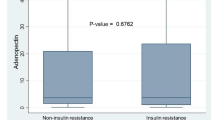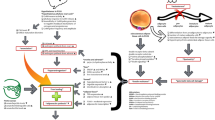Abstract
Objective
Adiponectin is an adipokine that is decreased in obesity and type 2 diabetes. Women with polycystic ovarian syndrome (PCOS) are obese and are at risk for type 2 diabetes. The objective of the current study was to investigate the relationship of adiponectin to obesity and insulin resistance in women with PCOS and severe insulin resistance.
Methods
Thirty women with PCOS and acanthosis nigricans indicating severe insulin resistance were included in the study. Eleven body mass index (BMI)-matched women with normal ovulatory cycles served as controls. Fasting glucose, insulin, and adiponectin levels were measured, and a standard oral glucose tolerance test (OGTT) with insulin levels was performed. To further investigate the role of insulin sensitivity on adiponectin levels, 10 women with PCOS were treated with 4 mg rosiglitazone daily for 6 months and adiponectin levels were measured before and after treatment.
Results
Fasting insulin levels (33.5 ±3.8 μ/mL; P <.001) and insulin area under the curve (AUC) during OGTT (536.2 ± 70.5 μU/mL; P <.01) were higher in women with PCOS, while glucose levels were similar to controls. Adiponectin levels were lower (P <.01) in women with PCOS (5.6 ±2.6 μg/mL) compared with controls (8.5 ±3.9 μg/mL). There was a significant negative correlation between adiponectin levels and fasting insulin levels (r = —0.40, P =.02), insulin AUC during OGTT (r = -0.47, P =.008), fasting glucose levels (r = -0.45, P =.01), and glucose AUC during OGTT (r = —0.51, P =.003). There was no correlation between BMI and serum adiponectin (r = -0.12, P =.508) in women with PCOS, while there was a negative correlation (r = -0.746, P =.013) in controls. There was a significant (P <.01) increase in adiponectin levels when treated with rosiglitazone, despite unchanged BMI.
Conclusion
These results indicate that in women with PCOS and severe insulin resistance, insulin sensitivity appears to be the major determinant of adiponectin levels rather than adiposity. Low adiponectin levels may predict women with PCOS who are at high risk for developing type 2 diabetes.
Similar content being viewed by others
References
Carmina E, Lobo RA. Polycystic ovary syndrome (PCOS): Arguably the most common endocrinopathy is associated with significant morbidity in women. J Clin Endocrinol Metab 1999;84:1897–9.
Knochenhauer ES, Key TJ, Kahsar-Miller M, Waggoner W, Boots LR, Azziz R. Prevalence of polycystic ovary syndrome in unselected black and white women of the southeastern United States: A prospective study. J Clin Endocrinol Metab 1998;83:3078–82.
Dunaif A, Segal KR, Shelley DR, Green G, Dobrjansky A, Licholai T. Evidence for distinctive and intrinsic defects in insulin action in polycystic ovarian syndrome. J Clin Endocrinol Metab 1998;183:2694–9.
Dunaif A. Insulin resistance and polycystic ovary syndrome: Mechanism and implications for pathogenesis. Endocr Rev 1997;18:774–800.
Legro RS, Kunselman AR, Dodson WC, Dunaif A. Prevalence and predictors of risk for type 2 diabetes mellitus and impaired glucose tolerance in polycystic ovary syndrome: A prospective controlled study in 254 affected women. J Clin Endocrinol Metab 1999;84:165–9.
Nakano Y, Tobe T, Choi NH, Mazda T, Tomita M. Isolated and characterization of GBP28, a novel gelatin-binding protein purified from human plasma. J Biochem 1996;120:803–12.
Scherer PE, Williams S, Fogliano M, Baldini G, Lodish HF. A novel serum protein similar to C1q, produced exclusively in adipocytes. J Biol Chem 1995;270:26746–9.
Arita Y, Kihara S, Ouchi N, et al. Paradoxical decrease of an adipose-specific protein, adiponectin, in obesity. Biochem Bio-phys Res Commun 1999;257:79–83.
Maeda N, Takahashi M, Funahashi T, Matsuzawa Y, Matsubara K. cDNA cloning and expression of a novel adipose specific collagenlike factor, apM1 (adipose most abundant gene transcript 1). Biochem Biophys Res Commun 1996;221:286–9.
Vionnet N, Hani E-H, Dupont S, et al. Genome wide search for type 2 diabetes-susceptibility genes in French whites: Evidence for a novel susceptibility locus for early-onset diabetes on chromosome 3q27-qter and independent replication of a type 2-diabetes locus on chromosome 1q21-q24. Am J Hum Genet 2000;67:1470–80.
Kubota N, Terauchi Y, Yamauchi T, et al. Disruption of adiponectin causes insulin resistance and neointimal formation. J Biol Chem 2002;277:25863–6.
Matsuda M, Shimomura I, Sata M, et al. Role of adiponectin in preventing vascular stenosis. J Biol Chem 2002;277:37487–91.
Ouchi N, Kihara S, Arita Y, et al. Novel modulator of endothelial adhesion molecules: Adipocyte-derived plasma protein adiponectin. Circulation 1999;100:2473–6.
Yamauchi T, Kamon J, Waki H, et al. The fat derived hormone adiponectin reverses insulin resistance associated with both lipoatrophy and obesity. Nat Med 2001;7:941–6.
Berg AH, Combs TP, Du X, Brownlee M, Scherer P. The adipocyte secreted protein Acrp 30 enhances hepatic insulin action. Nat Med 2001;7:947–53.
Weyer C, Funahashi T, Tanaka S, et al. Hypoadiponectinemia in obesity and type 2 diabetes: Close association with insulin resistance and hyperinsulinemia. J Clin Endocrinol Metab 2001;86:1930–5.
Stuart SA, Gilkison CR, Smith MM, Bosnia AM, Keenan BS, Nagamani M. Acanthosis nigricans as a risk factor for non-insulin dependent diabetes mellitus. Clin Pediatr 1998;37:73–80.
Barbieri RL. Hyperandrogenism, insulin resistance and acanthosis nigricans. 10 years of progress. J Reprod Med 1994;39:327–36.
Barbieri RL, Ryan KJ. Hyperandrogenism, insulin resistance, and acanthosis nigricans syndrome: A common endocrinopathy with distinct pathophysiologic features. Am J Obstet Gynecol 1983;147:90–101.
Zawadski JK, Dunaif A. Diagnostic criteria for polycystic ovary syndrome: towards a rational approach. In: Dunaif A, Givens JR, Haseltine F, eds. Polycystic ovary syndrome. Boston: Blackwell Scientific, 1992:377–84.
Kern PA, Di Gregorio GB, Lu T, Rassouli N, Ranganathan G. Adiponectin expression from human adipose tissue: Relation to obesity, insulin resistance, and tumor necrosis factor-α expression. Diabetes 2003;52:1779–85.
Pellme F, Smith U, Funahashi T, et al. Circulating adiponectin levels are reduced in nonobese but insulin-resistant first-degree relatives of type 2 diabetic patients. Diabetes 2003;52:1182–6.
Yamamoto Y, Hirose H, Saito I, et al. Correlation of the adi-pocyte-derived protein adiponectin with insulin resistance index and serum high-density lipoprotein-cholesterol, independent of body mass index, in the Japanese population. Clin Sci 2002;103:137–42.
Hotta K, Funahashi T, Arita Y, et al. Plasma concentrations of a novel adipose-specific protein, adiponectin, in type 2 diabetic patients. Arterioscler Thromb Vasc Biol 2000;20:1595–9.
Komshian HY, Carantoni M, Abbasi F, Reavan GM. Relationship between several surrogate markers of insulin resistance and quantification of insulin mediated glucose disposal in 490 healthy nondiabetic volunteers. Diabetes Care 2000;23:171–5.
Ducluzeau PH, Cousin P, Malvoisin E, et al. Glucose-to-insulin ratio rather than sex hormone-binding globulin and adiponectin levels is the best predictor of insulin resistance in nonobese women with polycystic ovary syndrome. J Clin Endocrinol Metab 2003;88:3626–31.
Orio F, Palomba S, Cascella T, et al. Adiponectin levels in women with polycystic ovary syndrome. J Clin Endocrinol Metab 2003;88:2619–29.
Panidis D, Kourtis A, Farmakiotis D, Mouslech T, Rousso D, Koliakos G. Serum Adiponectin levels in women with polycystic ovary syndrome. Hum Reprod 2003;18:1790–6.
Phillips SA, Ciaraldi TP, Kong AP, et al. Modulation of circulating and adipose tissue adiponectin levels by antidiabetic therapy. Diabetes 2003;52:667–74.
Maeda N, Takahashi M, Funahashi T, et al. PPAR-7 ligands increase expression and plasma concentrations of adiponectin, an adipose-derived protein. Diabetes 2001;50:2094–9.
Combs TP, Wagner JA, Berger J, et al. Induction of adipocyte compliment-related protein of 20 kilodaltons by PPAR gamma agonists: A potential mechanism of insulin sensitization. Endocrinology 2002;143:998–1007.
Yu JG, Javorschi S, Hevener AL, et al. The effect of thiazo-lidinediones on plasma adiponectin levels in normal, obese and type 2 diabetic subjects. Diabetes 2002;51:2968–74.
Kissebah AH, Vydelingum N, Murray R, et al. Relation of body fat distribution to metabolic complications of obesity. J Clin Endocrinol Metab 1982;54:254–60.
Cnop M, Landchild MJ, Vidal J, et al. The concurrent accumulation of intra-abdominal and subcutaneous fat explains the association between insulin resistance and plasma leptin concentrations: Distinct metabolic effects of two fat compartments. Diabetes 2002;51:1005–15.
Moshimaya H, Wu X, Sinha MK, et al. Differential regulation of adiponectin secretion from cultured human omental and subcutaneous adipocytes: Effects of insulin and rosiglitazone. J Clin Endocrinol Metab 2002;87:5662–7.
Cnop M, Havel PJ, Utzschneider KM, et al. Relationship of adiponectin to body fat distribution, insulin sensitivity and plasma lipoproteins: Evidence for independent roles of age and sex. Diabetologia 2003;46:459–69.
Author information
Authors and Affiliations
Corresponding author
Additional information
Supported in part by grants from the National Institutes of Health: ROI CA 45181 (M.N.).
Rights and permissions
About this article
Cite this article
Sepilian, V., Nagamani, M. Adiponectin Levels in Women With Polycystic Ovary Syndrome and Severe Insulin Resistance. Reprod. Sci. 12, 129–134 (2005). https://doi.org/10.1016/j.jsgi.2004.09.003
Published:
Issue Date:
DOI: https://doi.org/10.1016/j.jsgi.2004.09.003




